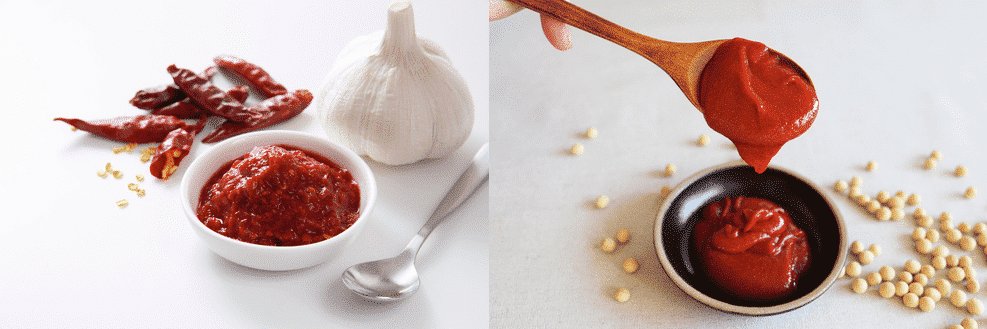
We all are familiar with Chinese and Korean dishes and have a special corner for these dishes in our hearts. Chinese and Korean dishes have some unique ingredients added into them with their sauces and pastes being the key to enhance and uplift the flavor of the dish even more.
Doubanjiang and Gochujang are also some of the most well-known Asian pastes around the world, but many people confuse these two pastes because both the pastes are from Asia, and both have soybeans in it.
In reality, both the pastes are different from one another and have different tastes and origins even though they have the same main ingredient in them. Thus, we are here to help you to know everything you need to know about these two pastes and aid you to differentiate them.
Doubanjiang vs Gochujang
Doubanjiang
Doubanjiang is a Chinese soybean paste. It is made from fermented soybeans, broad beans, and chilies. The paste is usually red or reddish-brown in color and has a small chunk of spices in it giving it a chunky and ragged texture.
The key flavor of Doubanjiang is hot, salty, spicy, and savory. It is used to make Sichuan cuisine and therefore, it is also called ” the soul of Sichuan cuisine.” It has no traces of sweetness in it and has a salty flavor. It comes in spicy and non-spicy flavors.
Gochujang
Gochujang is a Korean paste made up of chili powder, fermented soybean, barley powder and salt. It also includes starch of glutinous rice which adds the sweetness into the taste of Gochujang. The paste has a red or reddish-brown color to it because of the chilies. It has a smooth and velvety texture. Because of this smooth texture of the paste, it often caramelizes much faster and thus, one needs to be careful not to overcook or burn the paste.
The flavor of Gochujang is sweet, salty, savory, and has an earthy touch to it. It is usually a key ingredient to many Korean dishes.
Gochujang is more acidic and less layered, but it still has a fermented flavor. The texture of Gochujang can resemble a very thick peppery sauce. One can use Doubanjiang in place of Gochujang with slight effort but only if it is required for marination.
The Comparison
- Doubanjiang is an originated from China while Gochujang is from Korea
- The Gochujang is sweeter in taste while Doubanjiang has no traces of sweetness in it
- Doubanjiang is saltier than Gochujang
- Doubanjiang needs more time to dilute than Gochujang
- Doubanjiang is usually hotter, Gochujang is not
- Doubanjiang has broad beans powder in it while Gochujang has barley powder in it
- Doubanjiang is used in specific dishes, but Gochujang is used in many Korean dishes
- Doubanjiang has a chunky texture while Gochujang has a smooth and velvety texture
- Gochujang has an earthy touch in its flavor while Doubanjiang lacks this feature
- Gochujang can be burned or overcooked very easily thus, extra concentration is required
- Doubanjiang has a more fermented flavor than Gochujang
- Doubanjiang is easy to find in the eastern stores in the West while Gochujang is not available easily in the West
- We can use Doubanjiang in place of Gochujang with less effort but only if it needs to be used for marination. All that needs to be done is to add sweetener to it and give some more time for diluting it.
- Doubanjiang cannot be used as a table condiment as it is too salty for this purpose while Gochujang is often used as a table condiment, and it is served with Bibimpap which is a Korean dish.
- Doubanjiang also comes in two distinct types of flavors that is spicy and non-spicy while Gochujang has only one flavor.
Bottom Line
The Doubanjiang and Gochujang are completely different from one another based on their origin, time of fermentation, taste, and availability in the stores. Gochujang is more on the sweet side while Doubanjiang has no traces of sweetness in it and is salty in flavor. We hope our article helped you differentiate between Doubanjiang and Gochujang so that you do not mix them again when cooking.